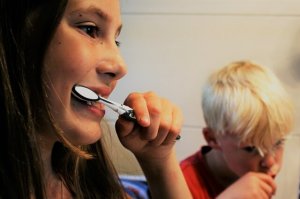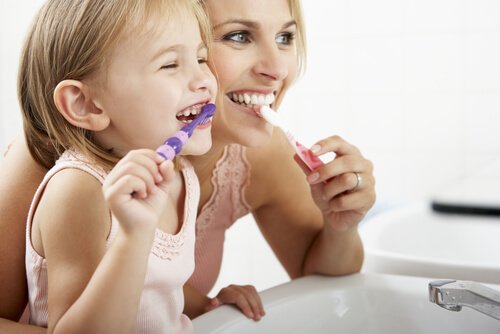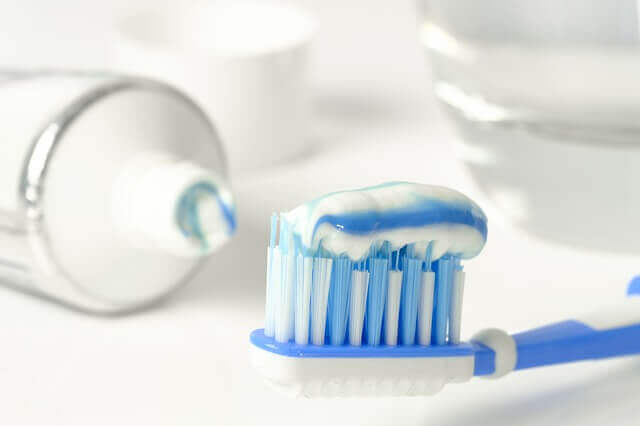How to Support Oral Hygiene at School

Oral hygiene at school is necessary, especially during preschool and elementary school. This isn’t only because it can help teach them good dental care habits, but also because it can help children develop a more positive image with their friends and classmates.
Remember that there are many children who eat breakfast and lunch at school. When they go such a long time without brushing their teeth, kids can develop bad breath. This, combined with poor hydration and a high-sugar diet can lead to cavities, gingivitis, and other problems.

The importance of oral hygiene
Oral hygiene is very important to leading a healthy life. This is because the oral cavity is the main way microorganisms enter our bodies. As a result, any problem in the oral cavity can extend to affect other parts of the body and manifest in undesirable outcomes.
Although it may not seem like it at first, teaching children not to put things in their moths, and to wash their hands helps prevent all types of illnesses. It promotes well-being, and consequently good educational development.
School is where kids learn certain things, and have other things they learned at home reinforced. Oral hygiene is no exception.
It’s important to cement this habit so that children grow up to be responsible adults who can take care of themselves, even in the simplest areas like dental health.
What is involved in oral hygiene at school?
1. Daily dental hygiene
At first, very young children should brush their teeth holding the brush horizontally. But after age 10, teach them that the bristles should be at a 45-degree angle with respect to the gums.
This is called the “Bass technique.” It significantly reduces the plaque that accumulates along the gum line.
Once kids are older than 10, the flouride concentration in toothpaste should be between 1000 and 1450 ppm. Don’t have kids this age rinse too much after brushing so that you can full take advantage of the effect of flouride on your teeth.

2. Good nutrition
Schools should include activities that help children understand the importance of eating healthy eating habits. This should also include learning what foods are healthy and which aren’t. A balanced diet has a direct effect on oral health for kids and adults.
3. Regular dentist visits
The topic of oral hygiene at school should teach children about the importance of regular dental exams. Teach your children about the importance of monitoring and checking their mouths.
Educational institutions can offer activities that teach children about what oral health professionals do and, of course, what should happen during a visit to the dentist.
This will help kids become interested in learning and help them lose their fear of going to the dentist.
Oral hygiene at school isn’t difficult to achieve if you set a good example and supervise your children.
It’s always a good idea to work as a team (parents and educators) to achieve your goals. This will make your job much easier for everyone involved, including your child.
Oral hygiene at school is necessary, especially during preschool and elementary school. This isn’t only because it can help teach them good dental care habits, but also because it can help children develop a more positive image with their friends and classmates.
Remember that there are many children who eat breakfast and lunch at school. When they go such a long time without brushing their teeth, kids can develop bad breath. This, combined with poor hydration and a high-sugar diet can lead to cavities, gingivitis, and other problems.

The importance of oral hygiene
Oral hygiene is very important to leading a healthy life. This is because the oral cavity is the main way microorganisms enter our bodies. As a result, any problem in the oral cavity can extend to affect other parts of the body and manifest in undesirable outcomes.
Although it may not seem like it at first, teaching children not to put things in their moths, and to wash their hands helps prevent all types of illnesses. It promotes well-being, and consequently good educational development.
School is where kids learn certain things, and have other things they learned at home reinforced. Oral hygiene is no exception.
It’s important to cement this habit so that children grow up to be responsible adults who can take care of themselves, even in the simplest areas like dental health.
What is involved in oral hygiene at school?
1. Daily dental hygiene
At first, very young children should brush their teeth holding the brush horizontally. But after age 10, teach them that the bristles should be at a 45-degree angle with respect to the gums.
This is called the “Bass technique.” It significantly reduces the plaque that accumulates along the gum line.
Once kids are older than 10, the flouride concentration in toothpaste should be between 1000 and 1450 ppm. Don’t have kids this age rinse too much after brushing so that you can full take advantage of the effect of flouride on your teeth.

2. Good nutrition
Schools should include activities that help children understand the importance of eating healthy eating habits. This should also include learning what foods are healthy and which aren’t. A balanced diet has a direct effect on oral health for kids and adults.
3. Regular dentist visits
The topic of oral hygiene at school should teach children about the importance of regular dental exams. Teach your children about the importance of monitoring and checking their mouths.
Educational institutions can offer activities that teach children about what oral health professionals do and, of course, what should happen during a visit to the dentist.
This will help kids become interested in learning and help them lose their fear of going to the dentist.
Oral hygiene at school isn’t difficult to achieve if you set a good example and supervise your children.
It’s always a good idea to work as a team (parents and educators) to achieve your goals. This will make your job much easier for everyone involved, including your child.
This text is provided for informational purposes only and does not replace consultation with a professional. If in doubt, consult your specialist.








